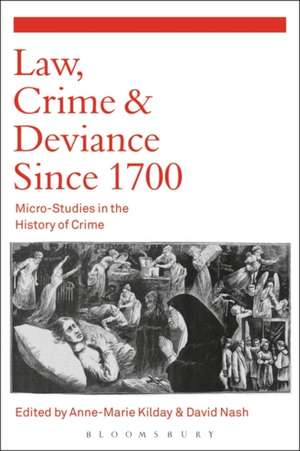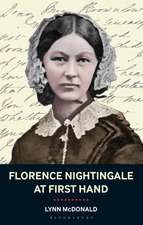Law, Crime and Deviance since 1700: Micro-Studies in the History of Crime
Editat de Professor David Nash, Anne-Marie Kildayen Limba Engleză Paperback – 16 noi 2016
| Toate formatele și edițiile | Preț | Express |
|---|---|---|
| Paperback (1) | 182.24 lei 3-5 săpt. | |
| Bloomsbury Publishing – 16 noi 2016 | 182.24 lei 3-5 săpt. | |
| Hardback (1) | 717.70 lei 6-8 săpt. | |
| Bloomsbury Publishing – 16 noi 2016 | 717.70 lei 6-8 săpt. |
Preț: 182.24 lei
Preț vechi: 209.73 lei
-13% Nou
Puncte Express: 273
Preț estimativ în valută:
34.88€ • 37.87$ • 29.30£
34.88€ • 37.87$ • 29.30£
Carte disponibilă
Livrare economică 01-15 aprilie
Preluare comenzi: 021 569.72.76
Specificații
ISBN-13: 9781472585288
ISBN-10: 1472585283
Pagini: 344
Dimensiuni: 156 x 234 x 19 mm
Greutate: 0.52 kg
Editura: Bloomsbury Publishing
Colecția Bloomsbury Academic
Locul publicării:London, United Kingdom
ISBN-10: 1472585283
Pagini: 344
Dimensiuni: 156 x 234 x 19 mm
Greutate: 0.52 kg
Editura: Bloomsbury Publishing
Colecția Bloomsbury Academic
Locul publicării:London, United Kingdom
Caracteristici
Shows how the micro-history method might be transferred beyond the individual case studies covered in this volume
Notă biografică
David Nash is Professor of History at Oxford Brookes University, UK. He is editor of the journal Social and Cultural History and author of several books, including Christian Ideals in British Society: Stories of Belief in the Twentieth Century (2013) and Blasphemy in the Christian World (2007).Anne-Marie Kilday is Professor of Criminal History at Oxford Brookes University, UK. She is author of A History of Infanticide in Britain (2013), co-author of Cultures of Shame: Exploring Crime and Morality in Britain 1600-1900 (2010) and editor (with David Nash) of Histories of Crime, 1600-2000 (2010).
Cuprins
Introduction (David Nash and Anne-Marie Kilday, Oxford Brookes University, UK)Section One - Criminality, State and Society1. The Uses of a Martyred Blasphemer's Death: The Execution of Thomas Aitkenhead, Scotland's Religion, the Enlightenment and Contemporary Activism (David Nash, Oxford Brookes University, UK)2. History, Narrative and attacking Chronocentricism in Understanding Financial Crime: The Significance of Micro-history (Sarah Wilson, University of York, UK)3. The Limits of Government Intervention: Caroline Wybrow and the Scandal of the Contagious Diseases Acts (Adrian Ager, Oxford Brookes University, UK)4. The Bonnie and Clyde of the Blackout: The Short Criminal Careers of Gustav Hulten and Elizabeth Jones (Clifford Williamson, Bath Spa University, UK)Section Two - Violence and the Violent5. Love, Vengeance and Vitriol: An Edwardian True-Crime Drama (Katherine D. Watson, Oxford Brookes University, UK)6. Constructing the Cult of the Criminal: Kate Webster - Victorian Murderess and Media Sensation (Anne-Marie Kilday, Oxford Brookes University, UK)Section Three - Police and Policing7. 'Hand in Glove with the Penny-a-liners': The Bow Street Runners in Narrative Fact and Fiction (David Cox, University of Wolverhampton, UK)8. Citizens' Complaints and Police (Un)accountability: The Career of a Parisian Commissaire de Police of the Belle Époque (Anja Johansen, University of Dundee, UK)9. Bobbies, Booze and Bagatelle: Policing Vice in Victorian London (Rachael Griffin, University of Western Ontario, Canada)Section Four - Prisoner Narratives and Confinement Stories10. 'I am afraid she is perfectly responsible for her actions and is simply wicked': Reconstructing the Criminal Career of Julia Hyland' (Helen Johnston, University of Hull, UK, Barry Godfrey, University of Liverpool, UK and Jo Turner, University of Chester, UK)11. Making their Mark: Young Offenders' Life Histories and Social Networks (Helen Rogers, Liverpool John Moores University, UK)12. Reflections on the Chain Gang and Prison Narratives from the Southern United States (Vivien Miller, University of Nottingham, UK)13. 'Nothing kept back, Nothing Exaggerated?' Piety, Penology and Conflict: Joseph Kingsmill, Prison Chaplain (1842-60) (Neil Davie, University of Lyon, France)BibliographyIndex
Recenzii
One of the most impressive aspects of the collection is the clarity with which each author explains their own approach to microhistory and its value and contribution to broader historical debates. The methodological explanations and cohesive approach offered throughout is especially valuable, as the reader understands why this approach matters and what it adds to the topic analysed and to wider issues relating to the history of crime.
The book . underlines the importance of the micro-historical approach to the history of crime and justice . One appreciates . reading this collective work of interesting contributions.
This is a broad, colorful collection of 13 narratives of crime and criminals and how their microhistories (case studies) illuminated the larger issues in criminal justice systems in Britain (mostly), the US, and Europe. This is history from below, but it is not statistical and is mercifully free of postmodern obscurities. Each case is fascinating. The various contributors cover such subjects as an acid attack by a jilted woman in the 1870s and her acquittal, thus illuminating gender considerations; the confinement of a supposed prostitute in a Victorian lock hospital; the disputed use in London in the 1840s of plainclothes policemen in pubs to nab Sunday drinkers; a murderous crime spree by an American deserter and his English girlfriend in wartime Britain; and Victorian white-collar crime, a subject scarcely understood then and often ignored by modern historians. There are also microhistories of convicts, including chain gang narratives from the southern US and transportees to Australia. Much of the detail in these narratives depends on the remarkable ability of historians today to use online primary sources to bring to life the forgotten. The book is scholarly and clearly written, extensively documented, and fascinating. Summing Up: Highly recommended. All academic levels/libraries.
Highlighting a diverse cast of characters - criminals, cops, clergy among others - this collection of essays about individuals and their relation to the criminal justice system in Britain, Europe and the United States provides a "bottom up" view of crime, police, and prisons. These microhistory case studies add an important dimension to generalized theories or statistics that describe structure and aggregate patterns of crime and criminal justice rather than unique experiences. In addition to specialists, students will find themselves engaged with the personal narratives that bring the past to life.
The book . underlines the importance of the micro-historical approach to the history of crime and justice . One appreciates . reading this collective work of interesting contributions.
This is a broad, colorful collection of 13 narratives of crime and criminals and how their microhistories (case studies) illuminated the larger issues in criminal justice systems in Britain (mostly), the US, and Europe. This is history from below, but it is not statistical and is mercifully free of postmodern obscurities. Each case is fascinating. The various contributors cover such subjects as an acid attack by a jilted woman in the 1870s and her acquittal, thus illuminating gender considerations; the confinement of a supposed prostitute in a Victorian lock hospital; the disputed use in London in the 1840s of plainclothes policemen in pubs to nab Sunday drinkers; a murderous crime spree by an American deserter and his English girlfriend in wartime Britain; and Victorian white-collar crime, a subject scarcely understood then and often ignored by modern historians. There are also microhistories of convicts, including chain gang narratives from the southern US and transportees to Australia. Much of the detail in these narratives depends on the remarkable ability of historians today to use online primary sources to bring to life the forgotten. The book is scholarly and clearly written, extensively documented, and fascinating. Summing Up: Highly recommended. All academic levels/libraries.
Highlighting a diverse cast of characters - criminals, cops, clergy among others - this collection of essays about individuals and their relation to the criminal justice system in Britain, Europe and the United States provides a "bottom up" view of crime, police, and prisons. These microhistory case studies add an important dimension to generalized theories or statistics that describe structure and aggregate patterns of crime and criminal justice rather than unique experiences. In addition to specialists, students will find themselves engaged with the personal narratives that bring the past to life.














